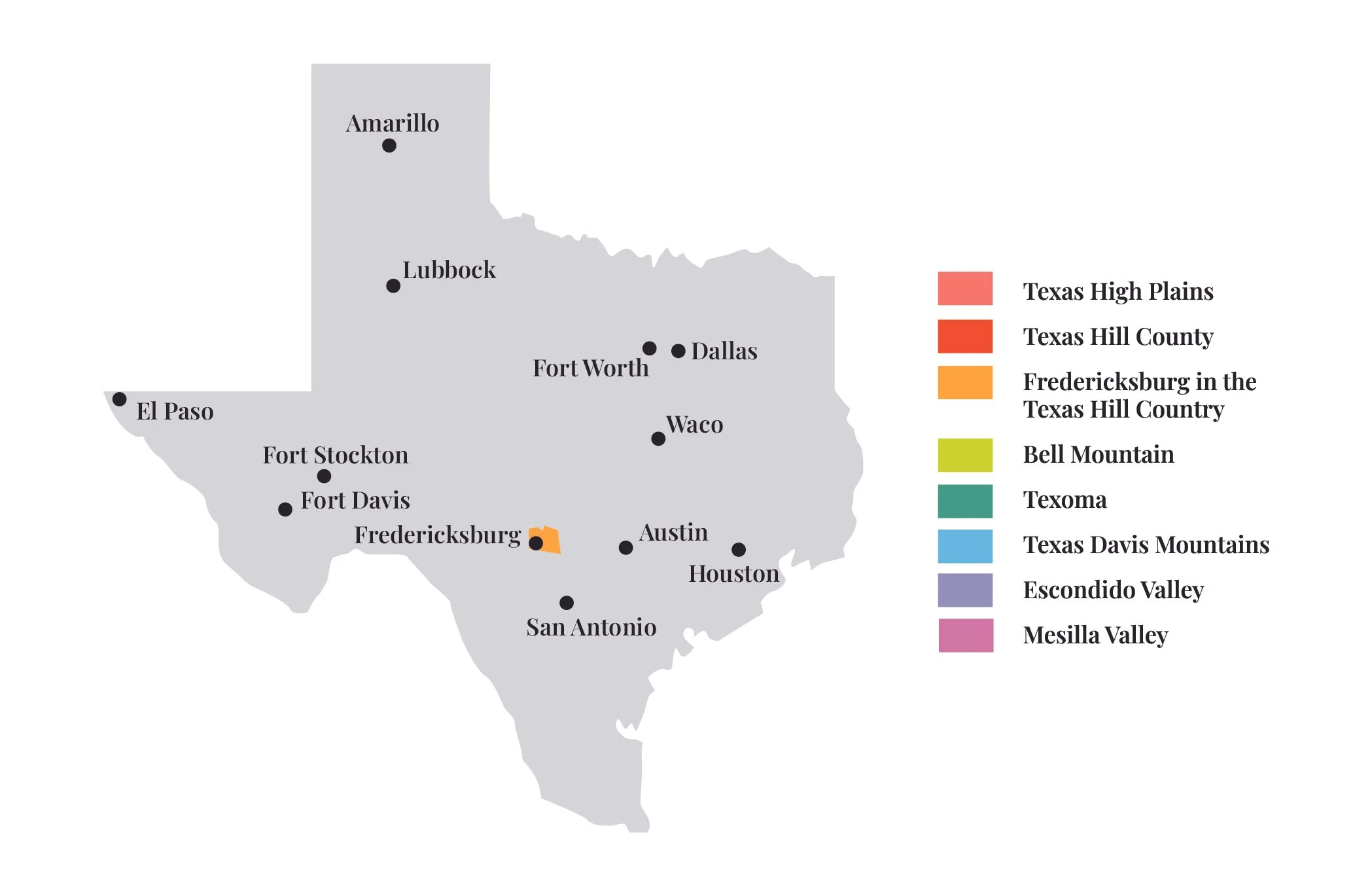Fredericksburg in the
Texas Hill Country AVA
German Roots, Texas Heart
Established in 1988, Fredericksburg in the Texas Hill Country American Viticultural Area (AVA) claims fame as Texas’s second‑oldest federally recognized wine region and the most tourism‑focused enclave within the larger Hill Country. Encircling the historic German town of Fredericksburg, this compact 110‑square‑mile bowl of limestone and granite slopes channels cool night air, crafting aromatic whites and Mediterranean‑style reds that have helped put Texas wine on the national map. For budding wine students, Fredericksburg AVA offers a lesson in how geology, elevation, and cultural heritage intersect to define terroir.
Location & Landscape
The AVA lies entirely within Gillespie County about 70 miles west of Austin and 75 miles north of San Antonio. Elevations range from 1,100 to 2,000 feet, with vineyards planted on rolling hills that radiate outward from the town center. The region’s ‘bowl’ topography traps warm daytime air while evening downslope breezes funnel through narrow creek beds, creating a reliable 20‑degree diurnal swing even in July. Slopes average 5–12 percent—steep enough for swift drainage yet gentle enough for mechanized viticulture.
Climate: Warm & Sunny with Reliable Night‑Time Relief
· Rainfall: 30–35 inches annually, concentrated in late spring thunderstorms and fall cold fronts.
· Temperature: Summer highs reach low 90s °F; nights dip into the upper 60s °F thanks to elevation‑driven breezes.
· Humidity: Slightly lower than eastern Hill Country; quick‑drying winds curb mildew pressure.
· Frost: Spring frost remains a risk; many growers employ wind machines or delayed pruning on lower slopes.
Bottom line: Expect ripe fruit flavors balanced by refreshing acidity—key to producing food‑friendly wines that pair with Fredericksburg’s famous schnitzel and sausage.
Terroir: Limestone & Granite—The Two Pillars
Most vineyards rest on shallow, alkaline clay loams over fractured limestone, particularly Edwards limestone, which reflects sunlight and moderates acids. North‑western pockets feature decomposed pink granite from the Llano Uplift, lending sandy textures and high quartz content that elevate aromatics in Syrah, Viognier, and Roussanne. Together these soils provide excellent drainage, forcing vines to grow deep roots and concentrate flavors while naturally restricting yields.
Signature Grapes & Why They Thrive
Tempranillo - Elevation mirrors Spain’s Rioja; thick skins handle late‑summer sun and sudden rainstorms.
Viognier - Limestone soils and dry breezes keep tight clusters rot‑free, unlocking apricot and honeysuckle aromas.
Mourvèdre - Late‑ripening red finds the long, warm Hill Country fall it needs to soften rustic tannins.
Sangiovese - Calcareous clays echo Tuscany; diurnal swing preserves cherry acidity and herbal notes.
Syrah - Granite sands intensify black‑pepper spice and lavender aromatics reminiscent of northern Rhône.
Roussanne - Heat‑tolerant white that retains beeswax texture and citrus zest on breezy slopes.
More than 40 grape varieties are recorded, but educators spotlight Mediterranean reds and Rhône whites as the most terroir‑expressive choices.
Interesting Facts
· Wine Road 290: Over 50 tasting rooms line a 30‑mile stretch east and west of Fredericksburg—second only to Napa’s Highway 29 for winery density.
· Oktoberfest Roots: Founded by German immigrants in 1846, Fredericksburg’s beer‑and‑brat culture now fuels wine‑centric festivals like the Fredericksburg Food & Wine Fest each October.
· Hotspot for Agritourism: The AVA welcomes more than 1 million wine tourists annually, boosting local hospitality and farm‑to‑table dining.
· Historic Peach Orchards: Gillespie County peaches often share acreage with vineyards, providing natural frost protection and an extra agri‑tourism draw.
Visiting & Nearby Cities
• Fredericksburg – Epicenter of tasting rooms, German bakeries, and boutique lodging
• Austin – 70 miles east (≈ 1 hour 15 minutes) via U.S. 290
• San Antonio – 75 miles southeast (≈ 1 hour 20 minutes) via U.S. 87/I‑10
• Johnson City & Hye – Gateway towns with art galleries and distilleries
Sample itinerary: Start with morning pastries on Main Street, taste along Wine Road 290, then hike Enchanted Rock at sunset for a granite‑top view of vineyard country.
Putting It All Together
Fredericksburg AVA demonstrates that micro‑terroir matters—even inside a vast region like the Hill Country. Granite and limestone slopes, tempered by evening breezes, yield wines that balance Texas sun with Old‑World structure. Study this AVA to see how elevation and soil interplay can guide grape selection and winemaking decisions in a warm climate.
· Limestone + diurnal swing = vibrant whites—compare a Fredericksburg Viognier to one from drier High Plains fruit.
· Granite amplifies spice—taste local Syrah alongside limestone‑grown bottles to spot lavender and black‑pepper lift.
Next time you enjoy a glass of Fredericksburg Tempranillo packed with cherry, leather, and dusty minerality, remember the German pioneers and pink granites shaping each sip.

